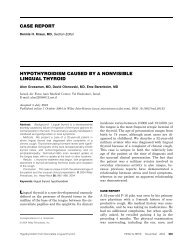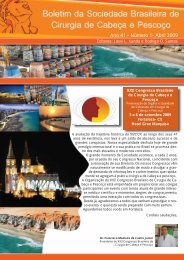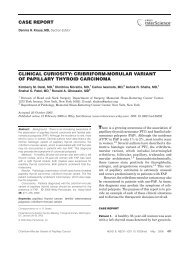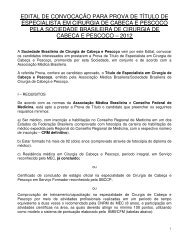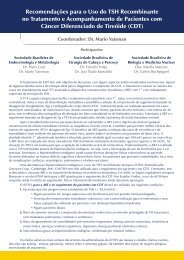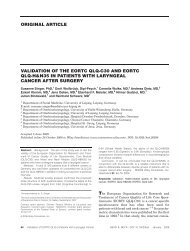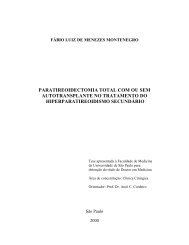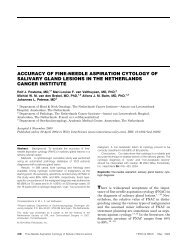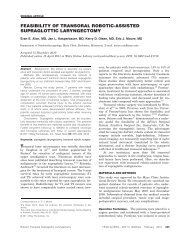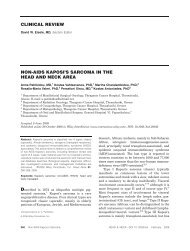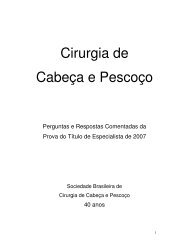Mastoid recurrence after radiotherapy for nasopharyngeal carcinoma
Mastoid recurrence after radiotherapy for nasopharyngeal carcinoma
Mastoid recurrence after radiotherapy for nasopharyngeal carcinoma
You also want an ePaper? Increase the reach of your titles
YUMPU automatically turns print PDFs into web optimized ePapers that Google loves.
CASE REPORT<br />
Russell B. Smith, MD, Section Editor<br />
MASTOID RECURRENCE AFTER RADIOTHERAPY FOR<br />
NASOPHARYNGEAL CARCINOMA: TWO CASE STUDIES<br />
Ximei Zhang, MD, Jingwei Luo, MD, Li Gao, MD, Guozhen Xu, MD<br />
Department of Radiation Oncology, Cancer Hospital, Chinese Academy of Medical Sciences (CAMS) and Peking<br />
Union Medical College (PUMC), Beijing, People’s Republic of China. E-mail: nqluo@yahoo.com.cn<br />
Accepted 14 January 2010<br />
Published online 31 March 2010 in Wiley Online Library (wileyonlinelibrary.com). DOI: 10.1002/hed.21391<br />
Abstract: Background. The mastoid is a rare site of <strong>nasopharyngeal</strong><br />
<strong>carcinoma</strong> <strong>recurrence</strong> <strong>after</strong> <strong>radiotherapy</strong>, and no<br />
relevant reports are currently in the literature.<br />
Methods. Two case reports are presented describing<br />
patients with a history of <strong>nasopharyngeal</strong> <strong>carcinoma</strong> who<br />
received primary radical <strong>radiotherapy</strong>. The first was treated by<br />
conventional <strong>radiotherapy</strong>, using 2-dimensional techniques,<br />
while the second was delivered by intensity-modulated radiation<br />
therapy (IMRT).<br />
Results. The patients presented with progressive mastoid<br />
<strong>recurrence</strong> <strong>after</strong> <strong>radiotherapy</strong> at 12 and 16 months, respectively.<br />
Clinical presentation of mastoid <strong>recurrence</strong> was similar<br />
to mastoiditis. Meanwhile, distant metastasis occurred in both<br />
cases. To date, 1 has died of distant metastasis, and the other<br />
is alive with disease stabilization following chemotherapy<br />
treatment.<br />
Conclusion. This is the first report of mastoid <strong>recurrence</strong> <strong>after</strong><br />
<strong>radiotherapy</strong> <strong>for</strong> <strong>nasopharyngeal</strong> <strong>carcinoma</strong>, which should<br />
alert clinicians to probe into the pathogenesis and pay attention<br />
to the relationship between mastoid <strong>recurrence</strong> and distant<br />
metastasis. VC 2010 Wiley Periodicals, Inc. Head Neck 33:<br />
1535–1538, 2011<br />
Keywords: <strong>nasopharyngeal</strong> <strong>carcinoma</strong>; <strong>recurrence</strong>; mastoid;<br />
<strong>radiotherapy</strong>; prognosis<br />
Nasopharyngeal <strong>carcinoma</strong> (NPC) is a common tumor<br />
among Chinese people. Radiotherapy is the main<br />
treatment administered <strong>for</strong> almost all NPC cases. Despite<br />
the fact that radical <strong>radiotherapy</strong> achieves a 5-<br />
year overall survival rate of more than 70%, 1,2 local<br />
failure remains the major problem <strong>for</strong> patients with<br />
advanced stages treated by conventional <strong>radiotherapy</strong>.<br />
Local <strong>recurrence</strong>s <strong>after</strong> conventional <strong>radiotherapy</strong><br />
<strong>for</strong> NPC are commonly located in the tissues<br />
within the irradiation field, such as ethmoid sinus<br />
and clivus; it is believed that local <strong>recurrence</strong>s might<br />
be related to low dose delivery there and inappropriate<br />
radiation field. 1 Thus far, no mastoid <strong>recurrence</strong>s<br />
have been detailed in the clinical literature.<br />
Correspondence to: Jingwei Luo, MD<br />
VC<br />
2010 Wiley Periodicals, Inc.<br />
CASE REPORT<br />
Case 1. A 45-year-old man was admitted to<br />
our hospital with complaints of decreased hearing<br />
in the left ear <strong>for</strong> 4 months and epistaxis <strong>for</strong><br />
half a month. Nasopharyngeal biopsy rendered<br />
the diagnosis of poorly differentiated squamous<br />
cell <strong>carcinoma</strong>. An MRI scan demonstrated a<br />
well-circumscribed mass in the left lateral wall<br />
extending into the ipsilateral parapharyngeal<br />
space and an enlargement of the bilateral cervical<br />
nodes (Figure 1). Further clinical workup,<br />
including chest radiograph, isotope bone scan,<br />
and abdominal ultrasonography scan, showed<br />
no evidence of distant metastasis and the disease<br />
was staged as T 2 N 2 M 0 , clinical stage III<br />
according to 2002 Union Internationale Contre<br />
le Cancer classification. The patient then underwent<br />
treatment with conventional radiation<br />
therapy using 2-dimensional techniques accompanied<br />
with a total dose of 70 Gy at 2-Gy daily<br />
fractions. The eustachian tubes were included in<br />
the radiation field and part of the temporal<br />
bones were out of the field, as shown in Figure 2.<br />
Images obtained at the end of <strong>radiotherapy</strong><br />
showed slightly enhanced mucosa in the nasopharynx;<br />
however, endoscopy revealed no residual<br />
tumor. The patient was then followed up<br />
regularly at the outpatient department without<br />
residual tumor evidence. About 1 year <strong>after</strong><br />
initial treatment, the patient presented to the<br />
same hospital with localized redness, swelling,<br />
and pain occurring in the mastoid area. An<br />
MRI showed an obvious mass in the left mastoid<br />
(Figure 3). A biopsy from the external ear<br />
was per<strong>for</strong>med and used to diagnose <strong>recurrence</strong>.<br />
Subsequently, the region of <strong>recurrence</strong><br />
was treated by intensity-modulated radiation<br />
therapy (IMRT) with a dose of 69.96 Gy in 33<br />
fractions. The tumor shrank slightly at the end<br />
NPC <strong>Mastoid</strong> Recurrence <strong>after</strong> RT HEAD & NECK—DOI 10.1002/hed October 2011 1535
FIGURE 1. MR image be<strong>for</strong>e treatment of patient 1 showed a<br />
well-circumscribed mass in the left lateral wall extending into<br />
the ipsilateral parapharyngeal space.<br />
FIGURE 2. The portal image of the radiation field of patient 1.<br />
The eustachian tubes were included in the field and part of the<br />
temporal bones were beyond the field.<br />
FIGURE 3. MR image showed mastoid <strong>recurrence</strong> in patient 1<br />
with an enhanced mass apparent in the left mastoid.<br />
of <strong>radiotherapy</strong>; however, multiple bone metastases<br />
occurred. After 4 cycles of chemotherapy<br />
consisting of vinorelbine (40 mg, days 1 and 8)<br />
and cisplatin (50 mg, days 2, 3, and 4), the disease<br />
remained progression-free at the last follow-up<br />
3 years <strong>after</strong> diagnosis.<br />
Case 2. A 43-year-old woman with a 7-month<br />
history of epistaxis and ear obstruction was<br />
diagnosed with undifferentiated NPC by <strong>nasopharyngeal</strong><br />
mass biopsy. The enhanced mass<br />
involved the right lateral wall extending to the<br />
parapharyngeal space, clivus, petrous apex, and<br />
right cervical nodes which were revealed on an<br />
MRI scan (Figure 4). After a detailed clinical<br />
workup, including chest radiograph, isotope<br />
bone scan, and abdominal ultrasonography scan,<br />
the disease was staged as T 3 N 1 M 0 , clinical stage<br />
III according to 2002 Union Internationale<br />
Contre le Cancer classification. Radiation therapy<br />
was per<strong>for</strong>med by IMRT using 9 coplanar<br />
beams (6-MV photon) 40 apart with a dose of<br />
7200 cGy divided into 33 fractions and delivered<br />
in 7 weeks. Figure 5 illustrates the tumor targets,<br />
dose distribution plan, and the portion of<br />
the temporal bones covered by 5000 cGy isodose<br />
curve. An enhanced T1-weighted MRI scan of<br />
the nasopharynx obtained at the end of the<br />
treatment revealed a high signal area, 1.5 cm <br />
1.5 cm, which was suspected to represent a<br />
region of persistent disease; however, endoscopic<br />
biopsy from the persistent area was unable to<br />
detect any residual tumor. The high-intensity<br />
1536 NPC <strong>Mastoid</strong> Recurrence <strong>after</strong> RT HEAD & NECK—DOI 10.1002/hed October 2011
FIGURE 4. MR image be<strong>for</strong>e treatment of patient 2 showed a<br />
well-circumscribed mass in the right lateral wall extending into<br />
the ipsilateral parapharyngeal space.<br />
feature was most likely radiation edema or<br />
infection of the <strong>nasopharyngeal</strong> mucosa. There<strong>for</strong>e,<br />
routine follow-up was administered and<br />
the disease remained <strong>recurrence</strong> free. Sixteen<br />
months later, the patient was admitted to the<br />
same hospital with complaints of right hearing<br />
loss and hemicrania. On physical examination,<br />
the patient was noted to have some signs of<br />
inflammation including localized redness, swelling,<br />
and increased skin temperature in the<br />
mastoid area which measured approximately<br />
3cm 2 cm. The patient received antiinflammatory<br />
treatment <strong>for</strong> half a month, which had<br />
no effect on suppressing the inflammation. An<br />
MRI scan revealed a relatively defined mass<br />
involving the right petrous bone and mastoid; a<br />
biopsy from the external ear proved <strong>recurrence</strong><br />
(Figure 6). At the same time, the B-ultrasonic<br />
examination showed multiple metastases in the<br />
liver and retroperitoneal lymph nodes. The<br />
patient was placed on palliative treatment with<br />
traditional Chinese medicine and died 3 months<br />
later.<br />
DISCUSSION<br />
The treatment failures <strong>for</strong> <strong>nasopharyngeal</strong> <strong>carcinoma</strong><br />
by <strong>radiotherapy</strong> are often attributed to<br />
local persistence or <strong>recurrence</strong>, regional lymph<br />
node metastasis, and distant metastasis. 1 The<br />
FIGURE 5. CT slice at the level of the mastoid <strong>recurrence</strong>. The<br />
gross target volume (GTV) is highlighted in red, and the planning<br />
target volume (PTV) in sky blue. Part of the mastoid is covered<br />
by 5000 cGy isodose curve. [Color figure can be viewed in<br />
the online issue, which is available at wileyonlinelibrary. com.]<br />
FIGURE 6. MR image showed mastoid <strong>recurrence</strong> in patient 2<br />
with a defined mass involving the right mastoid.<br />
NPC <strong>Mastoid</strong> Recurrence <strong>after</strong> RT HEAD & NECK—DOI 10.1002/hed October 2011 1537
local <strong>recurrence</strong> is usually identified in the<br />
nasopharynx cavity or adjacent organs such as<br />
sphenoid sinus, cavernous sinus, ethmoid sinus,<br />
and clivus; however, mastoid <strong>recurrence</strong> is<br />
extremely rare. To date, no related report citing<br />
such a find could be located in the clinical literature.<br />
It is speculated that eustachian tube<br />
involvement may play an important role during<br />
the process of mastoid <strong>recurrence</strong>. Anatomically,<br />
the eustachian tube links the lateral wall of the<br />
nasopharynx to the middle ear, which further<br />
connects mastoid cells through the mastoid<br />
antrum. Consequently, cancer cells may be able<br />
to spread to the tympanum along the mucosal<br />
lining then into the mastoid antrum. The 2<br />
patients we report here each presented with<br />
<strong>nasopharyngeal</strong> mass involving ipsilateral eustachian<br />
tube, there<strong>for</strong>e, it is logical to extrapolate<br />
that both of the mastoid <strong>recurrence</strong>s<br />
occurred ipsilaterally as described by the abovementioned<br />
anatomical hypothesis. The reason<br />
remains unknown why eustachian tube involvement<br />
with NPC is common, yet mastoid <strong>recurrence</strong><br />
is relatively rare.<br />
Both of our patients initially showed clinical<br />
features similar to mastoiditis when first diagnosed<br />
with mastoid <strong>recurrence</strong>, which suggests<br />
that the differential diagnosis <strong>for</strong> mastoid swelling<br />
<strong>after</strong> <strong>radiotherapy</strong> to treat the NPC should<br />
include both mastoiditis and tumor <strong>recurrence</strong>.<br />
Radiation-induced temporal bone tumors should<br />
also be considered depending on the timing from<br />
radiation therapy. In our 2 cases, the possibility<br />
of a radiation-induced temporal bone tumor having<br />
arisen from overlapping radiation fields was<br />
disproved according to Cahan’s criteria 3–5 ; the<br />
short interval period of <strong>recurrence</strong> (12 and<br />
16 months, respectively) and the same histology<br />
between the mass in the mastoid and the primary<br />
tumor indicated it was a recurrent tumor.<br />
To determine if inflammation was caused by<br />
infection related to posttherapy eustachian tube<br />
dysfunction, we administered antiinflammatory<br />
treatment and observed no therapeutic benefit.<br />
In addition, biopsy was critical to make the diagnosis<br />
clear. It is worth noting that both of our<br />
patients presented with distant metastasis<br />
almost at the same time of mastoid <strong>recurrence</strong>,<br />
there<strong>for</strong>e, it remains imperative that clinicians<br />
be vigilant when patients previously irradiated<br />
<strong>for</strong> <strong>nasopharyngeal</strong> malignancies present with<br />
mastoid complaints. It remains unclear whether<br />
patients with mastoid <strong>recurrence</strong> have an especially<br />
high risk of distant metastasis or poorer<br />
prognosis. Further studies are needed because<br />
of the rarity of such cases.<br />
CONCLUSIONS<br />
This is the first report on mastoid <strong>recurrence</strong> <strong>after</strong><br />
<strong>radiotherapy</strong> <strong>for</strong> <strong>nasopharyngeal</strong> <strong>carcinoma</strong><br />
and the relationship between mastoid <strong>recurrence</strong><br />
and distant metastasis. We also suggest<br />
that a definitive diagnosis of mastoiditis cannot<br />
be made unless imaging and biopsy rule out the<br />
possibility of a malignancy. Although the pathogenic<br />
mechanisms underlying NPC <strong>recurrence</strong><br />
in mastoid tissues remains unknown, the clinical<br />
reporting of these cases will encourage clinicians<br />
to consider this rare <strong>recurrence</strong> and pay<br />
attention to the relationship between mastoid<br />
<strong>recurrence</strong> and distant metastasis.<br />
REFERENCES<br />
1. Lee AWM, Perez CA, Law SCK, Chua DTT, Wei WI,<br />
Chong V. Nasopharynx. In: Perez CA, Brady LW, Halperin<br />
EC, editors. Principles and Practice of Radiation Oncology.<br />
Philadelphia: Lippincott Williams & Wilkins; 2008.<br />
p 1583–1586.<br />
2. Yi JL, Gao L, Huang XD, Li SY, Luo JW, Cai WM. Nasopharyngeal<br />
<strong>carcinoma</strong> treated by radical <strong>radiotherapy</strong><br />
alone: ten-year experience of a single institution. Int J<br />
Radiat Oncol Biol Phys 2006;65:161–168.<br />
3. Cahan WG, Woodard HQ, Higinbotham NL. Sarcoma arising<br />
in irradiated bone; report of 11 cases. Cancer 1948;<br />
1:3–29.<br />
4. Lustig LR, Jackler RK, Lanser MJ. Radiation-induced<br />
tumors of the temporal bone. Am J Otol 1997;18:230–<br />
235.<br />
5. Goh YH, Chong VF, Low WK. Temporal bone tumours in<br />
patients irradiated <strong>for</strong> <strong>nasopharyngeal</strong> neoplasm. J Laryngol<br />
Otol 1999;113:222–228.<br />
1538 NPC <strong>Mastoid</strong> Recurrence <strong>after</strong> RT HEAD & NECK—DOI 10.1002/hed October 2011



